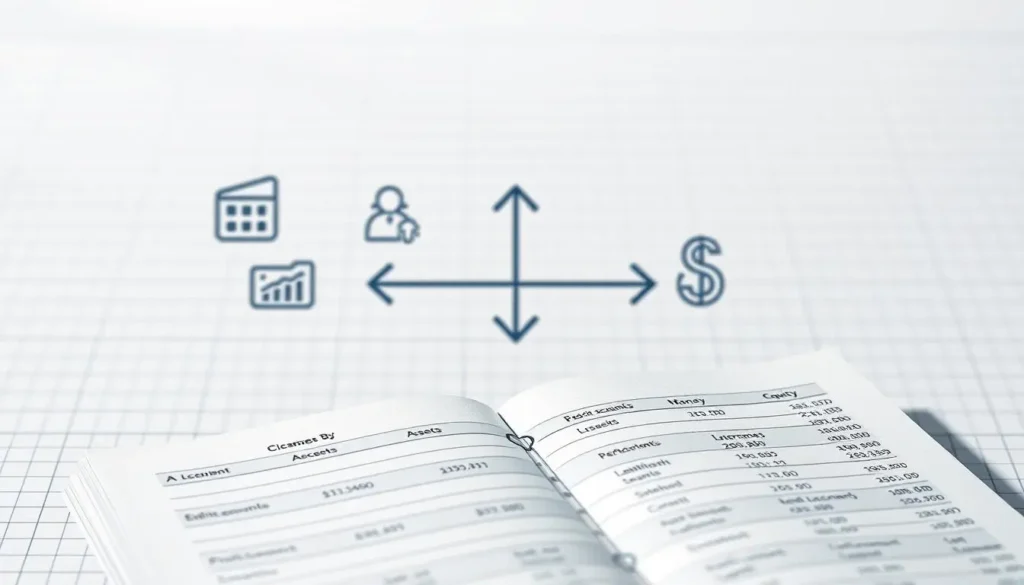Accounting Equation Basics: How Money Moves in Your Business
The accounting equation basics help you understand how money flows in your business. It’s simple: Assets equal Liabilities plus Equity. This rule shows how every dollar you own is funded by debt or investment.
This equation is key for small businesses in the United States. It’s the foundation of every balance sheet.
Think of the accounting equation as a safety net. In double-entry bookkeeping, every transaction has equal debits and credits. When they match, your records are accurate. If they don’t, a mistake is likely.
Fixing the mistake brings balance back to your books.

What is the accounting equation?
The basic accounting equation is at the heart of every financial record. It’s known as the balance sheet equation and the fundamental accounting equation. This framework helps track money and keeps totals balanced from the start.
The accounting equation formula is: Assets = Liabilities + Equity. It can also be shown as Equity = Assets − Liabilities or Liabilities = Assets − Equity. These formulas are useful when you know two values and need to find the third.
From Formula to Flow: How Money Moves Through Double-Entry Accounting

Money flows through your books in a clear way. Each entry has two sides, keeping totals balanced. This is the heart of double-entry bookkeeping, why your balance sheet stays balanced.
| Transaction | Debit (account & amount) | Credit (account & amount) | Effect on A = L + E |
|---|---|---|---|
| Owner invests $10,000 | Cash — $10,000 | Owner’s Equity (Contributed Capital) — $10,000 | Assets ↑ and Equity ↑ (balanced) |
| Bank loan $20,000 | Cash — $20,000 | Loan Payable — $20,000 | Assets ↑ and Liabilities ↑ (balanced) |
| Buy equipment with cash | Equipment — same amount | Cash — same amount | Asset-to-asset swap; total Assets unchanged (balanced) |
| Cash sale $1,000 | Cash — $1,000 | Revenue — $1,000 | Assets ↑; Equity ↑ via retained earnings (balanced) |
| Pay rent $800 | Rent Expense — $800 | Cash — $800 | Assets ↓; Equity ↓ via retained earnings (balanced) |
| Repay loan $500 principal | Loan Payable — $500 | Cash — $500 | Liabilities ↓; Assets ↓ (balanced) |
Using the Fundamental Accounting Equation to Guide Decisions
The fundamental accounting equation is key for every financial move. It’s like a map that shows how each choice affects assets, liabilities, and owners’ claims. This balance helps you see if your risk and return are in line.

Debt or Equity: A One-Minute Check
Use the fundamental accounting equation and the accounting equation formula (Assets = Liabilities + Equity) to choose funding. If you ask “what is the accounting equation?”. it’s the rule that keeps every move balanced. Take debt only when the project’s return is at least 3–5% above your after-tax interest and your DSCR is ≥ 1.25×. Quick test: Spread = (annual profit from funds − after-tax interest) ÷ funds. If the spread is under 3%, use equity or cut scope. That’s why people ask “which of the following statements best represents the reason for the accounting equation?”—it protects balance.
Don’t let debt-to-equity push past your industry’s norm.
Working Capital: Cash You Can Unlock Fast
Keep the basic accounting equation tight by shrinking the time between selling and getting paid. At $120k/month, cutting DSO 45→30 days frees about $60k. Do three things: invoice same day and add auto-pay; remind clients at 7/14/21 days; ask vendors for net-45/60 (but take 2/10, net 30 when offered—worth ~36% a year). Close by day 10 so retained earnings are real; when you need detail, the expanded accounting equation shows how revenue, expenses, and draws changed equity.
Conclusion
The accounting equation—Assets = Liabilities + Equity—keeps every entry tied to a balanced result. Use the accounting equation formula for daily checks; switch to the expanded accounting equation when you want to see what moved inside equity. Clean entries + quick reconciliations = reliable numbers and better decisions.
Ready to balance your books without the stress? Check out our Bookkeeping Lite Deals — smart offers that keep your accounting equation (and your wallet) happy.
FAQ
Which of the following statements best represents the reason for the accounting equation?
It ensures accuracy and completeness. The equation checks if assets and liabilities plus equity are equal. It ties every transaction to balanced records.
How does the accounting equation relate to the balance sheet?
The balance sheet shows assets on one side and liabilities plus equity on the other. Totals must match. If they don’t, there’s a recording error.
Does the accounting equation change under cash vs. accrual accounting?
No. Assets = Liabilities + Equity always holds. On accrual books you’ll see timing items (AR, AP, accrued expenses, deferred revenue). On cash books those timing items are smaller or missing—but the basic accounting equation still balances.
Where do prepaid expenses and deferred revenue fit in the accounting equation?
Prepaid expenses are assets (you paid now, benefit later). Deferred/unearned revenue is a liability (you were paid, you still owe the work). As you “use up” the prepaid, asset ↓ and expense ↑ (equity ↓). As you deliver the service, liability ↓ and revenue ↑ (equity ↑).
How do inventory purchases and sales flow through the equation?
Buy inventory for cash or on credit → Inventory (asset) ↑ and Cash ↓ or AP (liability) ↑. When you sell:
- Recognize revenue (Assets ↑ via Cash/AR; Equity ↑ via income).
- Record COGS (Inventory ↓; Equity ↓).
Revenue and COGS happen together to keep the fundamental accounting equation tight.
What do “contra accounts” do (accumulated depreciation, allowance for doubtful accounts)?
They reduce assets directly: accumulated depreciation lowers PP&E (net); allowance lowers AR (net). The offset runs through expenses, which reduces equity. Net effect: Assets ↓ and Equity ↓—equation still balanced.
How do leases hit the equation under ASC 842?
Most leases create a Right-of-Use (ROU) asset and a Lease liability at start—Assets ↑ and Liabilities ↑. Each payment splits into interest (expense → Equity ↓) and principal (Liability ↓; Cash ↓). Amortization lowers the ROU asset (Asset ↓). Balance holds the whole time. If you need granular equity drivers, use the expanded accounting equation.

